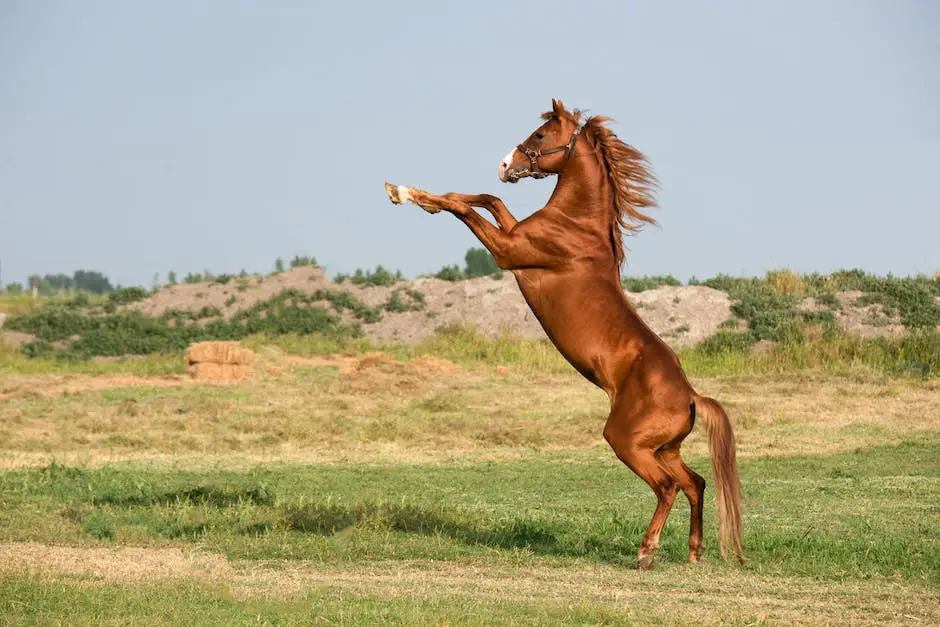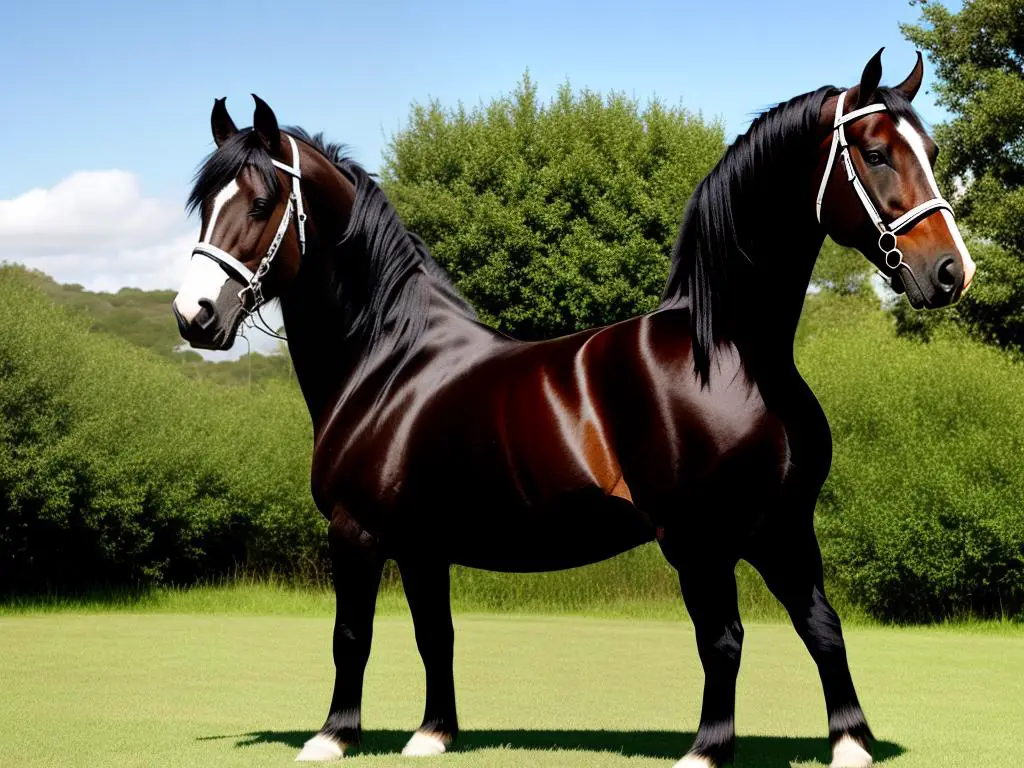Stoic and majestic, the Shire horse is a titan among equine breeds, renowned for its substantial size and stunning physical presence. A history rich with consistent selective breeding has gifted this imposing breed with remarkable size, making it one of the most recognizable draft horses globally. This essay aims to enlighten about the Shire horse breed, its unique characteristics such as height, weight, color patterns, and lifespan, and why size is a significant feature intrinsic to its identity. The comparison and contrast of the Shire’s size against other popular horse breeds like the Arabian horse, Clydesdale, and the Belgian Draft horse will provide deeper insight into this elegant giant. Furthermore, understanding the influence of size on the Shire horse’s health, lifestyle, and the various factors impacting their size arms potential breeders and enthusiasts with a comprehensive view of what to expect and how to raise this breed optimally.
Table of Contents (Horspedia)
Overview of the Shire Horse
Overview of the Shire Horse: A Magnificent Breed with Impressive Size
The Shire Horse breed traces its roots back to England with its history dating back to the Roman times. This majestic breed was initially used for its exceptional strength and endurance in wars, farming, and transportation of heavy goods. Over time, Shire Horses have been selectively bred to increase their size and strength, making them one of the largest horse breeds in the world.
Characteristics of the Shire Horse: Striking Appearance and Immense Size
In terms of height, a typical Shire Horse stands between 17 to 19 hands (68 to 76 inches or 173 to 193 cm), with some males exceeding 20 hands (80 inches or 203 cm). If you compare those measurements to an average person’s height of 5 feet 9 inches, a Shire Horse can be as tall or even taller. This remarkable size doesn’t stop at their height. Shire Horses are known to weigh between 1800 to 2400 pounds (816 to 1089 kilograms), which is almost ten times the average human weight.
The color patterns of Shire Horses are predominantly black, bay, or gray. However, brown, chestnut, and roan colors can also occur. Perhaps one of the most significant physical features, apart from their colossal size, are their distinguishing long, feathered legs, which add to their commanding appearance.
With a lifespan of about 25 to 30 years, the Shire Horse is resilient and enduring, especially when given proper care and living conditions.
The Size Factor: Setting the Shire Horse Apart
When it comes to horse breeds, the size is a huge factor that sets the Shire Horse apart. Their enormous size and power have contributed significantly to their popularity, but it’s not just about their physical prowess. This breed is also known for its gentle temperament.
Large enough to pull substantial weight, yet mild-mannered enough to be handled by children, the Shire Horse showcases an appealing balance of might and grace. This exceptional combination of physical and behavioral attributes has allowed the Shire Horse to maintain its relevance and popularity throughout history, from medieval battlefields to modern draft and show competitions.
In culmination, the Shire Horse embodies the perfect amalgamation of grand size, astonishing strength, remarkable lifespan, and a calm, gentle demeanor. This extraordinary combination of substantial size, complemented by their mild-mannered nature, sets them apart as an admired horse breed. They sit unrivaled at the pinnacle of size comparison within the equine world.

Size comparison with other horse breeds
Contextualizing the Size of a Shire Horse in Comparison with Other Horse Breeds
When examining various horse breeds, it’s crucial to consider physical attributes like size and weight. A leading example is the Shire Horse, a breed that hails from England and is admired worldwide for its extraordinary size and strength. In the following discussion, the size of the Shire Horse is compared to three other noteworthy breeds, namely the Arabian horse, the Belgian Draft, and the Clydesdale.
Shire Horse: The Gentle Giants
The Shire horse is one of the largest horse breeds in the world. They typically stand at a height of 16 to 18 hands (64 to 72 inches) high at the shoulder. The weight of a fully grown Shire horse ranges from 1,800 pounds to 2,400 pounds, with males often being heavier than females. They’re distinguished by their substantial bone structure, muscular build, and long, flowing hair known as “feathers” on their lower legs.
Arabian Horse: The Ancient Speedsters
In contrast, the Arabian horse is smaller and built for speed and endurance. The average Arabian stands at around 14.1 to 15.1 hands (56.4 to 60.4 inches) tall, significantly smaller than the Shire. Their weight is usually between 800 to 1,000 pounds, about half the weight of a typical Shire horse. With larger eyes and nostrils, a sculpted head, and a high tail carriage, their build leans toward agility rather than brute strength.
Belgian Draft Horse: The European Powerhouses
The Belgian Draft horse, native to the country of Belgium, is another large and powerful breed. They roughly match the Shire in height, typically standing 16 to 17 hands (64 to 68 inches) tall. Their weight, however, can surpass that of Shire horses; most Belgian Draft horses weigh between 1,800 to 2,200 pounds, with some even reaching up to 3,000 pounds. They are widely recognized for their stocky, muscular build, and robustness.
Clydesdale: The Majestic Workers
Originating from Scotland, the Clydesdale is a recognized symbol of hard work, strength, and style. Clydesdales are quite large, usually standing between 16 to 18 hands (64 to 72 inches), on par with the Shire horses. They weigh less though, averaging between 1,600 to 2,200 pounds. Renowned for their energetic, springy step, broad forehead, and wide-set eyes, Clydesdales beautifully blend size with agility.
Renowned as a giant in the horse world, the Shire Horse dwarfs many other breeds in both height and weight. While some breeds might come close to the Shire in size, they often fall short when it comes to weight. Yet each breed possesses its own unique set of skills and characteristics, honed over generations through selective breeding to deliver power, agility, endurance, and utility.

Impact of size on Shire Horse’s health and lifestyle
Implications of the Shire Horse’s Size on Its Health
The Shire Horse, celebrated for its awe-inspiring size and potency, stands among the world’s largest horse breeds. Fully grown Shire horses usually measure between 17 to 19 hands high (68 to 76 inches), and although uncommon, some can supersede these standards. They typically tip the scales at around 1,800 to 2,400 pounds with males often being slightly heavier than females.
However, the monumental size of the Shire Horse does not come without its share of health issues. The weight that these majestic creatures carry often results in hoof and leg problems. Conditions that can arise include laminitis, an inflammation causing severe pain in the tissues connecting the hoof wall to the foot, and osteoarthritis, a disease causing joint degradation. Equine Metabolic Syndrome, a metabolic disorder leading to obesity, laminitis, and insulin resistance, is also common.
Their monumental stature also puts them at an increased susceptibility to draft horse disorders such as Shivers and Chronic Progressive Lymphedema (CPL). Shivers is a neurological disorder causing muscle tremors and abnormal hind limb movements, while CPL is a progressive disease causing swelling, thickening, and fibrosis of the skin on the lower limbs. Both conditions are often associated with the physical stress these horses endure due to their extreme size.
How Size Influences the Life of a Shire Horse
The stature of a Shire horse remarkably influences its daily lifestyle, encapsulating feeding habits, training schedules, and equipment requirements. Because of their colossal size and metabolism, Shire horses often need a higher intake of calories compared to their smaller counterparts. They are generally fed a diet high in fiber, custom-tailored to support their overall health and cater to their vast energy needs.
Training methods for Shire horses need to be specially designed keeping their size and strength in mind. These horses are often put into jobs that call for brute strength due to their innate capability to pull heavy weights. Nonetheless, it’s essential that their training regimes remain flexible and gentle, considering their predisposition to joint injuries and metabolic disorders.
Given their size, typical horse gear barely suffices for Shire horses. They require equipment specially tailored or modified to their size to avoid discomfort or complications. This includes larger bridles, saddles, and harnesses and spacious living and training areas equipped with wider stalls and doors.
The lifestyle needs and healthcare of Shire horses, although intricately tied to their mammoth size and strength, require keen attention and careful handling. A well-informed approach to their upkeep promises a healthier, longer life for these gentle behemoths. It’s crucial to bear in mind that despite their awe-inspiring size, it’s the core of their health and lifestyle needs.

Factors Influencing Shire Horse Size
The Connection Between Shire Horse Size and Genetics
Among the many factors that contribute to a Shire horse’s size, genetics shows a considerable influence. Shire horses, native to England, are known to be one of the largest horse breeds, standing typically at a height of 17 to 19 hands (68-76 inches) at the shoulder. It’s the breed’s genetic makeup that plays a vital role in this impressive stature.
Key physical features such as bone structure, muscle density, and body size are typically the products of their inherited genetic traits. Factors like the size of a Shire horse’s parents, lineage, and genetically transmittable characteristics hold significant sway in determining its eventual size. This is something that breeders often take into account when selecting horses for reproduction.
Breeding Methods and Shire Horse Size
Breeding methods can certainly influence the size of Shire horses. For instance, selective breeding, which involves pairing horses that possess desirable traits such as large size, can lead to increased average size over generations. In contrast, breeding a Shire horse with a smaller breed could potentially result in offspring of a reduced stature when compared to purebred Shire horses.
However, it’s important to note that indiscriminate breeding for size can lead to health issues for these horses. It can disproportionately increase their weight, consequently leading to problems with mobility and adding stress to their joints and tendons.
Influence of Diet on Shire Horse Size
Diet also greatly influences a Shire horse’s growth and final size. A well-balanced, nutrient-rich diet that fulfills the breed’s specific dietary requirements is essential to optimal growth. This breed has a rapid growth rate, which means they need an increased supply of vitamins, minerals, and high-quality proteins, particularly in their infancy and adolescence.
Nevertheless, an over-nourishing diet can have adverse effects, causing horses to grow too quickly and potentially leading to developmental issues. It is crucial for horse owners to strike a balance between providing enough nutrients for growth while avoiding excessive calorie intake.
The Environment’s Role in Shire Horse Size
The environment a Shire horse is raised in can also affect its size to some extent. Horses that are kept in spacious areas where they can regularly exercise and move freely tend to be healthier and may grow larger than those kept in confined spaces. Access to plentiful and clean water, good ventilation and sunshine, and freedom from stress are all essential for a horse’s well-being and growth.
Hostile environmental conditions, such as extreme temperatures or unsanitary conditions, may stunt a horse’s growth, causing it to be smaller than average. So, proper care and a healthy living environment are integral for optimal growth of Shire horses.
Managing Size-Related Issues in Shire Horses
Understanding and managing size-related health issues will allow horse owners to ensure the wellbeing of their Shire horses. Regular vet checks to monitor growth rates and spot potential growth-related issues early on is essential. Furthermore, sufficient exercise, a nutritious diet, and ample living space are also crucial. It’s always advisable to consult with an equine veterinarian or nutritionist for personalized guidelines for your Shire horse’s dietary needs, given their large size. It helps to prevent various health issues such as obesity, joint disorders, and cardiac problems to name a few.
In conclusion, the Shire horse’s size is influenced by a complex interplay of genetics, breeding methods, diet, and environment. Careful consideration of these factors and their implications will help owners raise healthy and ideally sized Shire horses.

While size is a powerful aspect of the Shire horse, it is intrinsically linked with their health, everyday lifestyle, and the very perception of the breed itself. Understanding the factors influencing their size, from genetics, diet to environment aids in optimizing their robust features where possible and managing size-related issues. The Shire’s comparison with other horse breeds highlights their extraordinary grandeur and majesty. However, their size is a double-edged sword, bequeathing them with a unique allure and causing specific health challenges. Therefore, understanding, respect, and attentive care for these equine giants’ dimensions are essential for horse lovers, owners, and breeders philosophically appreciating and practically maintaining these royal creatures’ welfare.